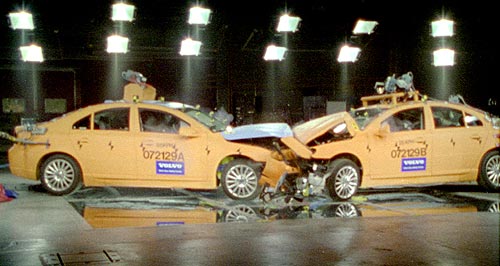Make / Model Search
News - VolvoVolvo safety chief calls for IsofixRear-facing seat: As well as lobbying for the local introduction of Isofix, Volvo safety chief Lotta Jakobsson recommends rear-facing seats for children under four years. Technical leader at Volvo calls for use of universal Isofix child seat system in Oz7 Apr 2011 ONE OF Volvo’s highest-profile global safety experts has called for changes to Australia’s child seat restraint laws, saying the international Isofix system should be given local design approval because it simplifies the process of fitting child seats. Professor Lotta Jakobsson is the technical leader of Volvo’s Safety Centre at Gothenburg in Sweden, and is a team convenor at the International Organisation for Standardisation (ISO), the body which created Isofix. In Australia to present the Safety Centre’s latest research to local child safety experts, Prof Jakobsson believes the current Australian system, in which child restraints are held in place by the car’s seatbelt along with a top tether strap fixed to an anchor point, is too complex and often applied improperly by parents. She says that while the current Australian standard for child restraint – one of the few local design rules that are not yet aligned with European design rules - is just as safe as Isofix in laboratory testing, the fact that many parents fail to fit their child restraints properly makes Isofix the better solution for the real world. “It’s not the technical functions of the safety system as such,” she says. “If you fit a child seat with the (seat) belt properly, you will get the same crash performance.  From top: Lotta Jakobsson, a child restraint fitted with ISOFIX attachment (in blue circle), still from a crash video showing the comparison between a forward-facing and rearward-facing seat in a frontal collision (the seats were side by side in original picture). From top: Lotta Jakobsson, a child restraint fitted with ISOFIX attachment (in blue circle), still from a crash video showing the comparison between a forward-facing and rearward-facing seat in a frontal collision (the seats were side by side in original picture).“I wouldn’t say this (Isofix) is a safer attachment given that you’ve done the right routing of the belt. That means if you are just looking at crashworthiness in a laboratory you might end up with the conclusion that it is not worthwhile.” A study by the RACV from 2004 found that as many as 70 per cent of restraints that currently comply under Australian Design Rules (ADRs) may be incorrectly installed. Isofix-compatible seats have rigid attachments in the base that clip into anchorage points within the rear seats, doing away with the complex system of feeding the seatbelt through the child restraint, which is what catches so many parents short. This is supported by a third attachment point, either in the form of top tether clips or a support leg that connects the child seat to the floor of the car. It is slightly different in the US, where the top tether attachment is combined with a flexible lower attachment that clips into the same universal anchorage as the European model. Prof Jakobsson is critical of this flexible attachment, saying: “That’s where some of the issues are. Are they correctly adjusted? This one (the rigid attachment) can never fail.” She recommends Australia adopt a combination of the rigid base attachment used in the Isofix system in Europe and the top tether attachment that is mandatory in the ‘Latch’ method in the US. “I think in Australia people are quite well trained to try to get this top tether routed, so it would make no sense to take it away. It’s more a question of making the rest of the system so easy. I would like the rigid attachment for the lower anchors and the flexible top tether would be the ideal for you,” she says. Prof Jakobsson said she is confident that regulators will come around to giving Isofix ADR approval, saying that the latest research coming out of Australia indicates that the tide of opinion may be turning. “I know that they’ve changed now, that they’re really into putting it (Isofix) into the recommendations. I’ve seen a draft, so they are thinking about it, which wasn’t the case half a year ago. The indications I’ve gotten is that they are considering it.” Apart from excluding Isofix from ADRs, Prof Jakobsson is critical of the lack of rearward-facing child seats for kids aged between six months and four years on the market. Volvo Cars, whose reputation and image revolves around its safety record, recommends rear-facing child seats be used for children up to three or four years of age, claiming that in frontal collisions a forward-facing child is more likely to be injured. This is because the child’s body is restrained, while his or her head – proportionately large compared to an adult – moves rapidly forward, putting undue load on their relatively underdeveloped neck muscles. A rearward-facing restraint more effectively cushions the blow, protecting relatively weak neck muscles. Rearward-facing child seats for children older than six months are now ADR-approved, with Victoria rolling out the change in November 2009 and the other states following suit during 2009-10. Prof Jakobsson blames the lack of take-up of rearward-facing restraints for children between the ages of six months and four years on a lack of awareness of its benefits and a lack of products on the market that fit the bill, saying that this is: “a big concern for us, that since it is possible now in Australia to actually use rear-facing seats up to four (years of age,) I think it is a shame that it’s not the case because it can easily be done.”  Read more |
Click to shareVolvo articlesResearch Volvo Motor industry news |










Facebook Twitter Instagram